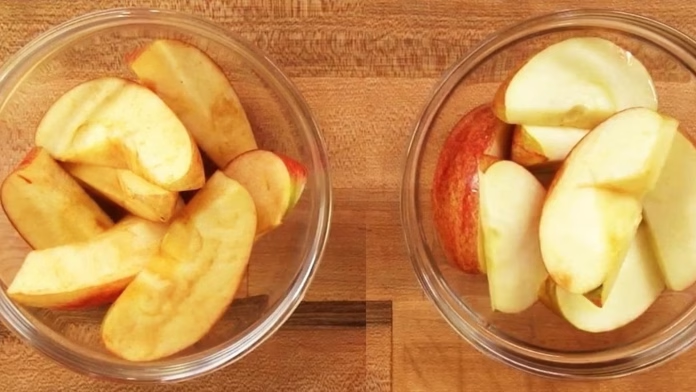Freshly cut fruits are a healthy and refreshing snack that many of us enjoy. However, one common problem that often occurs when we slice or chop fruits is browning. Browning not only affects the appearance of the fruits but also indicates a loss of freshness and can negatively impact their taste. Fortunately, there are several hacks and techniques that can help prevent fruit browning and keep your freshly cut fruits looking and tasting their best. In this article, we will delve into the science behind fruit browning, explore why it matters to prevent it, and present you with five incredible tips to maintain the freshness of your cut fruits.
The Science Behind Fruit Browning
To understand how to prevent fruit browning, it’s essential to grasp the science behind it. When fruits are cut or bruised, an enzyme called polyphenol oxidase (PPO) is released from the fruit cells. When PPO comes into contact with oxygen in the air, it reacts with polyphenols naturally present in the fruit, resulting in the formation of brown pigments known as melanins. This process, known as enzymatic browning, is responsible for the unappealing color change in cut fruits.
Why Preventing Fruit Browning Matters
Preventing fruit browning goes beyond aesthetics. The browning reaction indicates a loss of quality and freshness in the fruit. Additionally, enzymatic browning can cause a change in flavor and texture, making the fruit less appetizing. By employing effective techniques to prevent fruit browning, you can preserve the visual appeal, taste, and nutritional value of your freshly cut fruits.
Five Tips to Prevent Freshly Cut Fruits from Turning Brown
- Store In Air-tight Food Bags
One simple and effective way to prevent fruit browning is by storing the cut fruits in air-tight food bags. This method limits the fruit’s exposure to oxygen, reducing the enzymatic browning reaction. Place the freshly cut fruits in a sealable plastic bag, removing as much air as possible before sealing. Alternatively, you can use vacuum-sealed bags or specialized containers designed to keep fruits fresh for longer. This technique works well for fruits like apples, pears, and bananas.
- Soak The Fruits In Ginger Ale
Ginger ale, with its carbonation and low pH, can act as an effective anti-browning agent for certain fruits. The carbonation helps create a barrier between the fruit and the oxygen in the air, while the low pH inhibits the enzymatic browning reaction. To use this method, prepare a mixture of ginger ale and water in equal parts. Soak the freshly cut fruits in this solution for about 10 minutes, then drain and rinse them before serving. This technique is particularly suitable for fruits like peaches, pears, and apples.
- Immerse Fruits In Salt Water
Saltwater can also help prevent fruit browning due to its ability to draw out moisture from the fruits. By removing moisture, the saltwater reduces the contact between the enzymes and the polyphenols in the fruits, thereby inhibiting browning. Create a solution by dissolving half a teaspoon of salt in four cups of water. Submerge the freshly cut fruits in the saltwater solution for a few minutes, then drain and pat them dry before consumption. This method works well for fruits like avocados, pears, and apples.
- Add Lemon Juice
Lemon juice is a well-known and widely used natural remedy to prevent fruit browning. The high acidity of lemon juice helps slow down the enzymatic browning process. The juice provides a protective coating on the fruit’s surface, minimizing its exposure to oxygen. To utilize this technique, squeeze fresh lemon juice onto the freshly cut fruits, ensuring all exposed surfaces are coated. Alternatively, you can create a mixture of lemon juice and water and soak the fruits in it briefly. This method is particularly effective for fruits like apples, pears, and bananas.
- Dip Them In Honey Water
Honey, with its natural enzymes and low pH, can serve as an excellent anti-browning agent for freshly cut fruits. The enzymes present in honey help neutralize the enzymes responsible for browning, while the low pH inhibits their activity. Prepare a mixture of one tablespoon of honey with one cup of water. Dip the freshly cut fruits into the honey water solution for a few seconds, then remove and allow them to air dry before serving. This technique works well for fruits like apples, pears, and peaches.
Additional Tips for Maintaining Fruit Freshness
In addition to the techniques mentioned above, here are some additional tips to help you maintain the freshness of your cut fruits:
- Store cut fruits in the refrigerator to slow down the enzymatic browning process.
- Avoid using metal utensils when cutting fruits, as they can accelerate browning reactions.
- Keep the fruits hydrated by spraying or misting them with water before storing.
- Use specialized fruit preservatives or ascorbic acid (vitamin C) powder to inhibit browning.
- Cut the fruits just before serving to minimize the exposure to oxygen and delay browning.
Final Thoughts:
With these mind-blowing hacks and techniques, you can say goodbye to browning fruits and keep your freshly cut fruits looking fresh, appetizing, and delicious. Understanding the science behind fruit browning and employing preventive measures not only enhances the visual appeal of the fruits but also preserves their taste and nutritional value. Whether it’s storing fruits in air-tight bags, soaking them in ginger ale or saltwater, adding lemon juice, or dipping them in honey water, these tips will help you enjoy fresh and vibrant fruits every time. So go ahead, explore these hacks, and elevate your fruit snacking experience!





